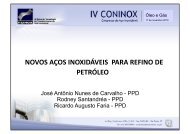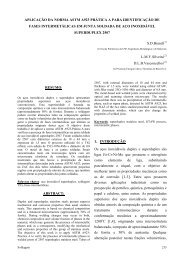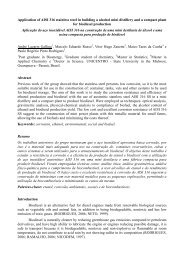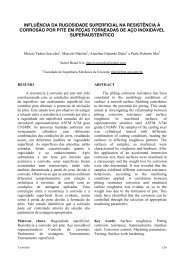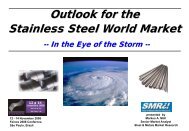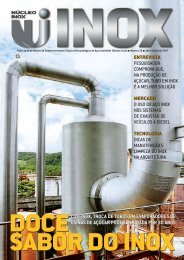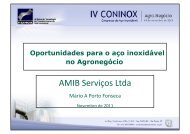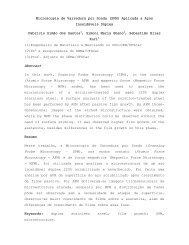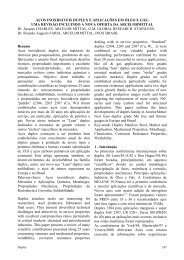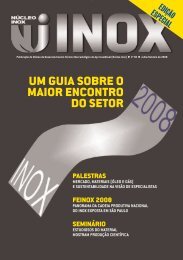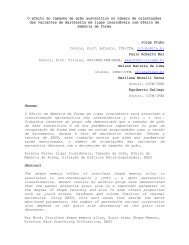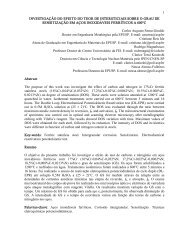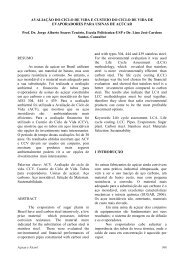Orbital Welding of Duplex Stainless Steel Tubing and
Orbital Welding of Duplex Stainless Steel Tubing and
Orbital Welding of Duplex Stainless Steel Tubing and
You also want an ePaper? Increase the reach of your titles
YUMPU automatically turns print PDFs into web optimized ePapers that Google loves.
It is generally agreed that duplex stainless steels benefit from the addition <strong>of</strong> filler metal overalloyed in<br />
nickel <strong>and</strong> nitrogen. However, for some small bore tubing, acceptable ferrite counts <strong>and</strong> corrosion<br />
resistance have been achieved with autogenous welding. This has been accomplished by the use <strong>of</strong><br />
shield gas containing helium, argon <strong>and</strong> 2% nitrogen (Hayes, M.D. <strong>and</strong> B.K. Henon, 2002).<br />
<strong>Orbital</strong> welding <strong>of</strong> duplex stainless steel for subsea umbilical tubing is continuing. Several<br />
manufacturers <strong>of</strong> coiled tubing have told AMI, that this would not be possible without the use <strong>of</strong> orbital<br />
welding. Umbilical tubing is typically welded with a Model 95 or a Model 79 weld head feeding wire.<br />
AMI has recently been active in assisting with the development <strong>of</strong> the PQR/WPS for umbilical tubing<br />
in Brazil.<br />
Petrobras in Brazil is a major player in this industry. The P-52 platform, recently commissioned, is<br />
largest in the world. BrasFELS Shipyard was given an award by Petrobras for their excellence. Weld<br />
criteria for duplex stainless steels must include ferrite counts or evaluation <strong>of</strong> the mechanical properties<br />
<strong>of</strong> the weldment since a good looking weld alone does not assure a good weld. A weld can have a good<br />
appearance while still have unacceptable ferrite numbers or deleterious phases that result in<br />
embrittlement. In order to accomplish repeatable welds with all <strong>of</strong> the favorable properties <strong>of</strong> the<br />
qualification welds, there must be proper <strong>and</strong> repeatable end preparation, joint configuration, purging<br />
techniques, <strong>and</strong> operator training.<br />
Installers must be aware <strong>of</strong> the unique properties <strong>of</strong> the material <strong>and</strong> to underst<strong>and</strong> the need for strict<br />
adherence to the qualified weld procedures (WPS). Precise, consistent control <strong>of</strong> heat input is essential.<br />
In addition, purging with inert gas is even more critical for duplex than for austenitic stainless steels for<br />
the retention <strong>of</strong> corrosion resistance. The recommendations for cleaning, end-preparation, welding<br />
environment, purging for manual welding <strong>of</strong> duplex stainless steels (Messer et. al, 2010) apply to<br />
orbitally welded duplex stainless steel as well.<br />
The PQR for the Petrobras duplex stainless steel pipe made specific requirements for welding <strong>of</strong> duplex<br />
stainless steel, as outlined in the S<strong>and</strong>vik <strong>and</strong> DNV St<strong>and</strong>ards that would be very difficult to achieve by<br />
manual welding. To our knowledge this is the first time that a specification has gone so deeply into the<br />
details <strong>of</strong> a welding procedure. Compliance with the requirement for stringer beads or limiting the<br />
amount <strong>of</strong> oscillation <strong>of</strong> the weld bead, the upper <strong>and</strong> lower limits <strong>of</strong> heat input per pass with a maximum<br />
<strong>of</strong> 0.5-2.5 kJ/mm (10-65 kJ/inch), <strong>and</strong> the requirement for continuous welding virtually dem<strong>and</strong>ed the use<br />
<strong>of</strong> mechanized or orbital welding equipment.<br />
<strong>Orbital</strong> welding with a proven WPS is the most reliable method for welding <strong>of</strong> duplex alloys.<br />
Unfortunately, installing contractors using manual welders working in the pipeshop or field environments<br />
are not always able to consistently meet the same quality requirements as those <strong>of</strong> the qualification welds<br />
that were done under ideal conditions. There have been several occasions when manually welded duplex<br />
<strong>and</strong> super duplex weldments have failed in service. It should be apparent that working in the deepwater<br />
environment drives up cost <strong>of</strong> repairing welds <strong>and</strong> weld failures may be catastrophic. However, there is<br />
very little in the welding literature to document the causes <strong>and</strong> effects <strong>of</strong> weld failures.<br />
In an article on CalEnergy’s use <strong>of</strong> corrosion resistant alloys (Van Wijngaarden, M., <strong>and</strong> J. Chater, 2006)<br />
they stated “With failures we reach a topic that is sometimes overlooked: welding.” The authors<br />
interviewed Project Manager for CalEnergy, George Furmanski who indicated that in the United States<br />
there are not many companies that can provide proper welding specialists or welding equipment. Mr.<br />
Furanski is quoted as saying “The majority <strong>of</strong> the stress corrosion cracking failures that we have seen<br />
occurred in the weld or the heat-affected zone. We therefore now tend to favor companies that use fully<br />
automatic welding machines. Our biggest technical challenge right now is to find people who can weld<br />
2507 duplex.”




